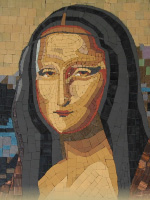Home
Welcome to the world of mosaics. Before making my acquaintance, please take some time to discover what are mosaics and the Picassiette style. Then glance at a few notes I wrote on the place of contemporary mosaics in art. Take a look at a few of my mosaic works and if you wish, contact me! Alan Willsie.

Mosaic art, or mosaics?
The word mosaic is derived from the Latin word musivum (opus musivum, or work done in a grotto, or grotto of the « muses », the term for which was museaea) to mosaicum, and in Italian « mosaico ». A mosaic can be defined as ”the assemblage, set in mortar, of small elements, usually stone, marble, glass paste, terracotta or even enamel, creating a flat or curved surface” (translated from Lavagne, 1987). From there, only imagination limits creativity. The perfect multi media.
Origins of mosaic art
The most ancient mosaics known date from 3000 to 4000 BC and were found in regions of today’s Syria. At Uruk, mosaics were made with painted ceramic cones inserted in mortar (Lavagne, 1987; Farneti, 1993). At Ur, certain mosaics were composed of shells and cut stones fixed in plant resin, a similar technique used by the Mayas (Fiorentini and Fiorentini, 2002).
The “Picassiette” style
The “Picassiette” style is named in honour of Raymond Isidore, who created mosaics with found shards and other objects with which he covered the walls of his house in Chartres. A journalist named him « Picassiette », in reference both to the French term « pique-assiette » (plate stealer) and Picasso. A good book for picassiette mosaic lovers to consult is: Hurley (1998). Other references are indicated in the following pages.
